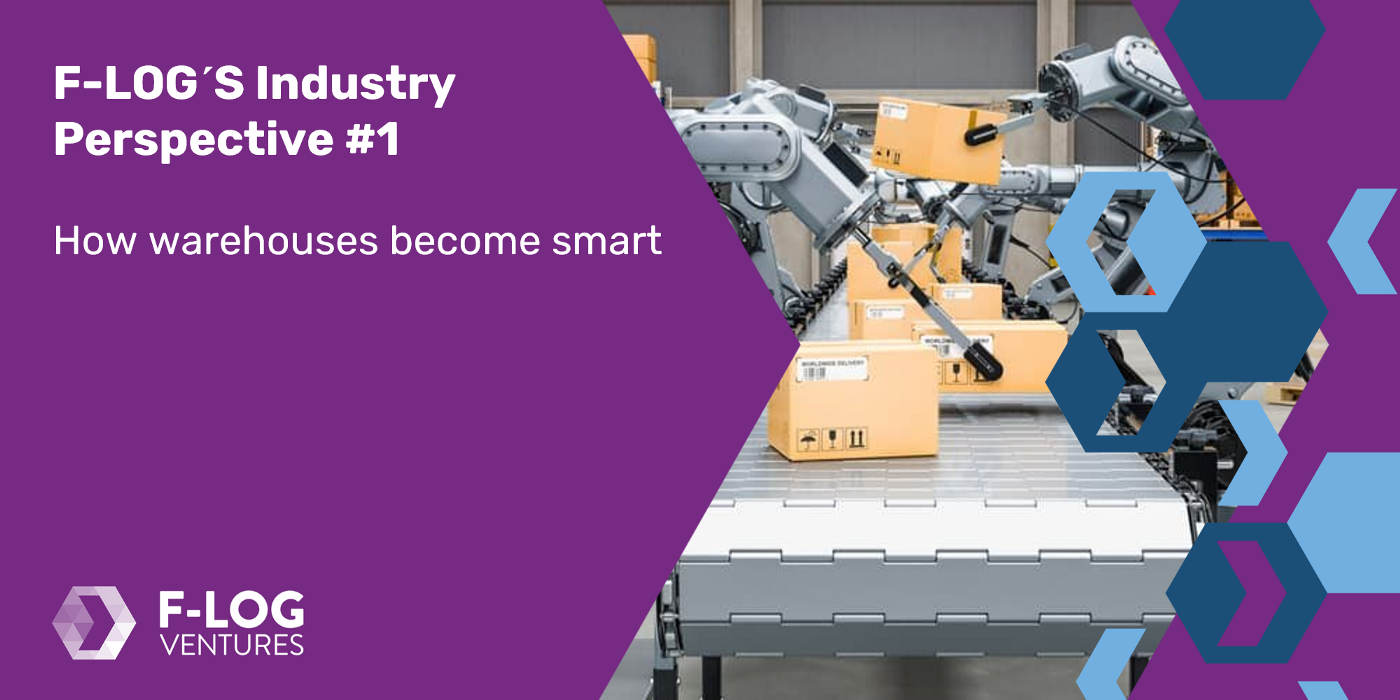This is the first article of our new blog series, F-LOG´s Industry Perspectives, which we want to use to irregularly share our view and industry insights on some of the hottest topics in the LogTech space. We start with an overview of the current situation of robotics in intralogistics.

Again and again, we have encountered business models and technologies around the topic of smart warehousing and robotics in intralogistics in the past months. We took this as an occasion to dig a little deeper into intralogistics use-cases for robotics and how they drive the trend of smart warehousing.
Macro-level trends as a key driver for more automation
Demand for more automation in intralogistics is rising because the ever-growing e-commerce sector is transforming order structures and buying habits of consumers. Consumer expectations are shifting towards faster and cheaper delivery services, reinforced by Amazon’s business model of these past years.
Another important factor is the human resources problem — rising costs and a shortage of workers support the need for more automation. Especially after Covid-19, investments in robotics and automation are economically more attractive since a larger share of value creation will again take place directly in industrialized countries, where labour costs are already at a very high level.
Overall, logistics service providers have to take advantage of using robots in their warehouses to tackle these challenges, reduce operational costs and increase productivity.
Massive growth ambitions of the robotics market
The trend for more automation is also reflected in the market numbers and forecast for the next years. The robotics market is expected to grow from USD 76.6 billion in 2020 to USD 176.8 billion by 2025; that corresponds to a CAGR of 18.2%. Especially collaborative robots are expected to grow at the highest CAGR during the forecast period. Therefore, this blog article will have a closer look at the technology that takes on dangerous, repetitive and difficult jobs and which enables humans to perform their jobs with more creativity and flexibility, leading to more efficiency and productivity in the warehouse.
Three key technologies and relevant startups that enable smarter warehouses today
There are various types of robots that are used for intralogistics solutions to handle tasks such as picking and delivery, stock movement and material handling or quality inspections. In the following we will focus on three key technologies such as Autonomous Mobile Robots (AMRs), Articulated Robot Arms (ARAs), Unmanned Aerial Vehicles (UAVs) and their practical impact on daily operations today.
1. Autonomous Mobile Robots (AMR)
AMRs are used especially for materials handling and evolved from Automated Guided Vehicles (AGV). While conventional AGVs can only follow fixed paths and move to predefined points on the guided path, the vision-based system of AMRs uses touch-based sensors, onboard computers, and AI to move in dynamic warehouse environments to any accessible location. Yet, AMRs not only present a great chance to improve intralogistics processes but also a huge market opportunity. The AMR market comes with double-digit growth and more than USD 10 billion in revenue in 2023.
One practical example of AMRs that work collaboratively alongside warehouse associates is Locus Robotics, a robotic unicorn funded with over USD 250 million. Locus offers a Robots as a Service (RaaS) subscription-based program that makes it easy to add AMRs to warehouse operations and shift capital expenses for automation to operational or labour expenses.
Its AMRs act as picking assistants but contrary to other systems, the warehouse associate does not follow the robot after the pick — instead, he is directed to the closest robot nearby for more work while the initial robot moves on to the next task, often with a different associate. This process enables shorter cycle times, 2–3 times greater productivity and a 129% greater ROI.
Other well-funded AMR startups are 6 River Systems, founded in 2015 and acquired by Shopify in 2019 for USD 450 million, InVia Robotics (USD 29 million funding) or Magazino (USD 50 million funding), to name a few.
2. Articulated Robotic Arms (ARA)
ARAs have flexible joints and articulated robotic arms to move and lift items in the warehouse. They’re typically used for picking and placing packages onto racks, palletizing, loading and unloading inventory as well as sorting packages. The challenges that make these tasks extremely complex are the diversity in packaging materials, the identification of single items within a box, and the different shapes of each product or package. That’s why ARA startups are creating robots that come very close to human capabilities, both in terms of hardware and software. Most labour (up to 80%) in a warehouse is dedicated to picking and packing, and ARAs have become very efficient in performing these tasks. Today, most ARAs are used in manufacturing since the tasks are more standardized and not as complex as in intralogistics. To deliver the results described above, ARAs rely on enabling technology, which is why the right software for these robotic arms is as important as the hardware itself.
A good example of this use case is Osaro, a San Francisco-based artificial intelligence startup, funded with more than USD 60 million whose software powers practical robotics automation solutions using technology such as advanced machine learning for visual perception and easy to integrate APIs. It enables the robotic arms to adapt automatically to moderate task variations, to detect all types of objects and to deploy easily and fast. The result is a scalable solution that works accurately (successful grip rate >99.5%) with cycle times as low as 3.5 seconds, delivering higher productivity and improved supply chain resilience. Another startup that provides an ARA end-to-end solution including software and hardware for e-commerce order fulfilment is RightHand Robotics, based in the US and funded with more than USD 30 million.
3. Unmanned Aerial Vehicles (UAV)
Unmanned Aerial Vehicles, or drones, can handle tasks that other robots cannot due to gravity. Use of UAVs is increasing although they are not as widespread as the other types of robots. Their main purpose at the moment is inventory checking. However, they can also analyze safety requirements such as racking and fire hazard inspections. Since they can execute their tasks at great heights and in dangerous environments, they also increase the safety of workers. Accidents often result in serious injuries that come with serious costs and a loss in revenue. The average work-related injury results in USD 38,000 indirect expenses and USD 150,000 in indirect costs. Therefore, higher safety levels produce an economic advantage over time.
The FIEGE Group, a leading European logistics company that specializes in efficient supply chain solutions, already completed a successful trial with UAVs when automating stocktaking at one of its multi-user warehouses. doks. innovation GmbH, a German early-stage startup, provided the technology: drones equipped with a barcode scanner and a camera that process the relevant data and forward them to the Warehouse Management System as well as a connected AGV enabling flying times of up to five hours. Stocktaking at this specific warehouse with 30,000 pallet spaces would usually require considerable personnel resources. Having the drone handling the actual job all by itself, it only required three shifts and one supervisor to intervene in case of an emergency. This results in two advantages: decreased labour costs and clearly fewer staff on site, which in times of strict hygiene protocols and a risk of a COVID-19 outbreak is definitely a positive.
What can we take from this?
Robotic applications across intralogistics are definitely an important topic when it comes to process automation and improved productivity.
Logistics service providers should evaluate to what degree they can use robots to keep up with a competitive market environment and rising challenges such as labour shortages, changing customer expectations or fluctuating order structures.
The market potential is huge, and the recent decade has shown that the technology is evolving fast. Also, new business models might come up: Companies do not want to acquire automation assets anymore. Robotics as a Service could be interesting to reduce CAPEX, facilitate more flexible cost structures, and reduce one-time investments, thereby lowering the entry barrier and making technology applications more scalable.
The human workforce remains essential. Robots are there to support human workers on tasks that are dangerous, repetitive or difficult, so they are free for tasks that involve creativity or demanding decision making. Human-robot collaboration shall empower humans and robots to exploit their intrinsic strengths.
Let´s talk!
However, robotics not only present an opportunity for logistics providers but also for venture capital firms (see the startups mentioned above). Therefore, we are very happy to talk to founders that focus on making warehouses smarter and advancing automation across intralogistics. Just drop us a line on LinkedIn or send us an e-mail.



